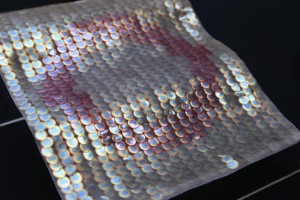 While fashion may not be the most obvious place to look for sustainable choices, this industry, too is increasingly aware of the need for better choices. From biobased shoes and eco-cotton to sustainable dyeing and production options, eco-friendliness today has definitely come into fashion.
While fashion may not be the most obvious place to look for sustainable choices, this industry, too is increasingly aware of the need for better choices. From biobased shoes and eco-cotton to sustainable dyeing and production options, eco-friendliness today has definitely come into fashion.
A concept presented earlier this year at Milan Design Week by Elissa Brunato, a designer graduating from Central St Martins in London is a case in point. Working with researchers Tiffany Abitbol and Hjalmar Granberg, both from RISE – Research Institutes of Sweden- to explore the use of cellulosics in new roles, Brunato developed a bio iridescent cellulose nanocrystal sequin for her “Future Sequin” project.
Sequins are commonly used decoration, yet if lost in the wash, they become a source of plastic pollution. This led Brunato to look for an alternative.
“In general, people were in awe that the sequins were shimmering naturally as they were first convinced that the material was petrol based, purely from its visual appearance,” said Elissa Brunato.
The shimmering effect is achieved by orienting the nanocrystals at the nanoscale to create structures that, in turn, give rise to interference of light. It is an effect seen in nature (butterflies, beetles, nacre, Pollia Condensata berries, etc.) that is difficult to reproduce in manmade materials. Brunato’s bio iridescent sequin uses naturally abundant materials to create shimmering structural colours. With no chemical colorants added to her sequin, Brunato has managed to use structure to recreate a pattern and colour previously made using oils and plastics.
Colours are reflected when the length-scale of the structures is in the visible spectrum and the iridescence arises (different colours seen at different angles) due to variations in the film structure. This interesting feature of cellulose nanocrystals, namely the ability to form liquid crystals that can be dried into coloured and iridescent films, has driven the researchers to want to understand more about how structure can be controlled and used for different properties.
“It’s interesting to understand how to control the self-assembly behaviour that gives rise to these colours. Can we for instance speed up the process to create fast drying, iridescent cellulose nanocrystal coatings? Can we improve mechanical properties and water resistance of the films, whilst maintaining their structural colours?” said Tiffany Abitbol.
The sequins are just one step along the way to explore new forms of cellulose and nanocellulose.
“This research project is driven by curiosity and a desire to find bio-based and biodegradable alternatives to today’s fossil-based materials,” said Hjalmar Granberg.
“It was wonderful, being able to show how the merging of different industries can bring forth new approaches to topics such as sustainability,” said Elissa Brunato.
Contacts
Hjalmar Granberg
Phone: +46 768 767041
E-Mail: hjalmar.granberg@ri.se
Tiffany Abitbol,
Phone: +46 703 776036
E-Mail: tiffany.abitbol@ri.se
Source
Bioplastics MAGAZINE, 2019-08-06.
Supplier
Elissa Brunato - Designer
Research Institutes of Sweden (RISE)
Share
Renewable Carbon News – Daily Newsletter
Subscribe to our daily email newsletter – the world's leading newsletter on renewable materials and chemicals









